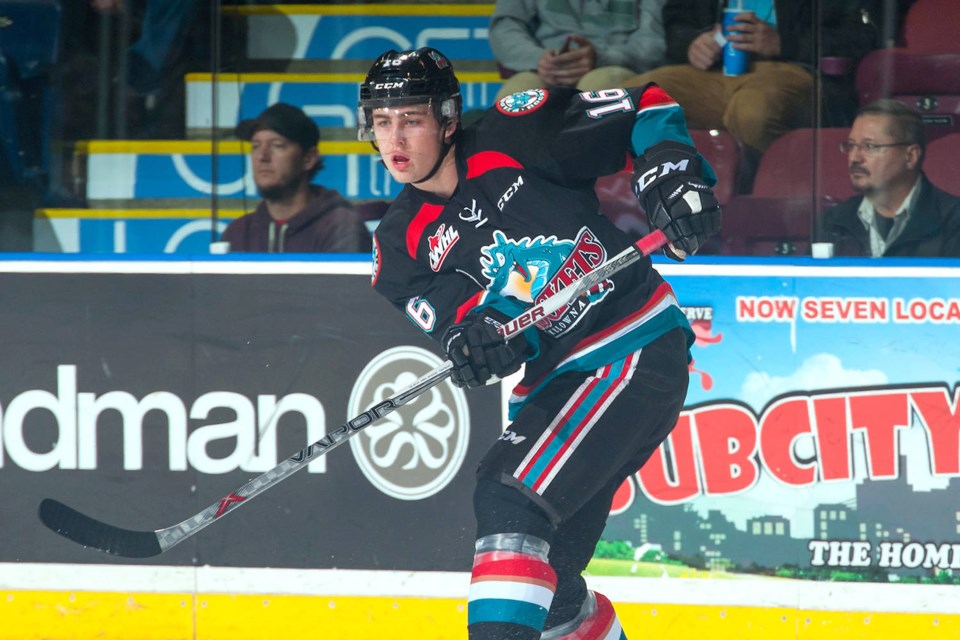Late in the first round of the 2017 NHL Entry Draft, , ŌĆ£Why isnŌĆÖt anyone taking Kole Lind?ŌĆØ
Anyone listening in on the Canucks draft table wouldnŌĆÖt have been surprised to hear Benning lean into the microphone and select the Kelowna Rockets winger early on day two of the draft. While Lind wasnŌĆÖt a first round pick on everyoneŌĆÖs draft rankings, he clearly was high on the CanucksŌĆÖ list.
ŌĆ£ItŌĆÖs cool that they were so high on me,ŌĆØ says Lind. ŌĆ£I was expecting to go maybe later in the first round, but as the night went on, I kinda got over it and woke up the next morning and said to myself, ŌĆśItŌĆÖs going to be a good day.ŌĆÖŌĆØ
Lind is looking for a few more good days in the coming year: he has been , where heŌĆÖll attempt to get his name in the mix for the final roster in December. When it comes to Team Canada, he can lean on a veteran alumni of CanadaŌĆÖs national team: fellow native of Shaunavon, Saskatchewan, Hayley Wickenheiser.
ŌĆ£IŌĆÖve skated around with her quite a few times,ŌĆØ he says, ŌĆ£and weŌĆÖve done some hockey schools together. I did a skills camp with her last year. She sent me a tweet after I got drafted, so I thought that was pretty cool. IŌĆÖve always been around her growing up.ŌĆØ
╠²
Big congrats to Kole Lind, on being drafted 33 overall by . Another Shaunavon, Sk. product.Must be the Water!
ŌĆö Hayley Wickenheiser (@wick_22)
╠²
When asked what he's taken from Wickenheiser, he says, ŌĆ£I think the biggest thing is working hard and staying with the same goal. The biggest thing everyone looks for is how hard you work and how much of a pro you are off the ice as much as you are on the ice. SheŌĆÖs just tried to help me be the best player I can be.ŌĆØ
Lind is already one of the top WHL scorers in his draft class. Lind led the Kelowna Rockets in scoring with 30 goals and 87 points in 70 games, incidentally just 8 points behind 6th overall pick Cody Glass in scoring.
In fact, Lind is not far behind Glass in a number of statistical categories and his selection should help cushion the blow for anyone devastated that the Canucks took the slick, skilled Swedish centre over the WHL playmaker in the first round.
Glass was third among first-time draft eligible skaters in the WHL with 68 primary points ŌĆö goals and first assists ŌĆö but Lind was not far behind with 60. At 5-on-5, both Lind and Glass had 20 goals, while Glass had slightly more first assists: 27 to LindŌĆÖs 21.
Digging a little deeper using numbers calculated by , Lind had 2.36 even-strength points per 60 minutes of ice time, just a little behind GlassŌĆÖs 2.49. They were both involved in a large percentage of their teamŌĆÖs goals as well: 35.28% for Glass and 31.62% for Lind.
The big difference comes down to position: centres are more valuable than wingers and Lind is seen as more of a complementary player than an offensive catalyst on his own.
The thing is, Lind was absolutely an offensive catalyst for the Rockets last season. Two Rockets forwards finished with higher points per game than Lind: Dillon Dub├® and Reid Gardiner. They were both injured for large portions of the season. With Dub├® and Gardiner out of the lineup, Lind scored at a higher rate than with them in the lineup. He wasnŌĆÖt dependent on them for points; instead, he stepped up when they were gone.
Lind had 15 goals and 40 points in 32 games without either Dub├® or Gardiner in the lineup, a point-per-game pace of 1.25. With both Dub├® and Gardiner in the lineup, he scored 8 goals and 33 points in 27 games, a pace of 1.22.
While Lind certainly benefited from the playmaking of his teammates, he made things happen with his own playmaking ability and quick release on his shot. Is it any wonder that Jim Benning was baffled that no one took Lind late in the first round?
╠²



